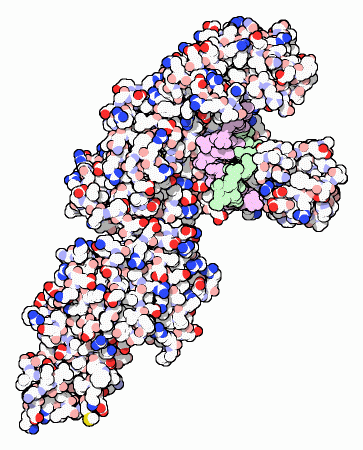|
Inhaltsübersicht | Nanomaschinen | Moleküle | Programme | Kurse | Fun | Links |
||
| > |
DNA Polymerase

The Secret of Life
DNA polymerase plays the central role in the processes of life. It carries the weighty responsibility of duplicating our genetic information. Each time a cell divides, DNA polymerase duplicates all of its DNA, and the cell passes one copy to each daughter cell. In this way, genetic information is passed from generation to generation. Our inheritance of DNA creates a living link from each our own cells back through trillions of generations to the first primordial cells on Earth. The information contained in our DNA, modified and improved over millennia, is our most precious possession, given to us by our parents at birth and passed to our children.Amazing Accuracy
DNA polymerase is the most accurate enzyme. It creates an exact copy of your DNA each time, making less than one mistake in a billion bases. This is far better than information in our own world: imagine reading a thousand novels, and finding only one mistake. The excellent match of cytosine to guanine and adenine to thymine, the language of DNA, provides much of the specificity needed for this high accuracy. But DNA polymerase adds an extra step. After it copies each base, it proofreads it and cuts it out if the base is wrong.
Prisoners and Pedigrees
Your DNA is unique to you, more unique than any fingerprint. Your DNA is a mixture of your mother's and your father's DNA, plus perhaps a few mutational changes. This uniqueness has been used to great advantage in criminal forensics. If a drop of blood is left at a crime scene, the DNA may be analyzed and compared with the DNA of a suspected criminal. If they match, the criminal has been caught in the act.Of course, there is very little DNA in a dried drop of blood. This is where DNA polymerase enters the world of forensics. A small sample of DNA is multiplied using PCR (the polymerase chain reaction), creating a large sample that may be easily analyzed. The tiny sample is placed in a test tube, and DNA polymerase is added to make a copy. Then the sample is heated up momentarily, and the two strands of DNA separate. Then DNA polymerase builds a new double helix from each strand. These two copies are then heated, and duplicated, yielding four copies. After many times, a large quantity of identical DNA strands are produced. Our own DNA polymerases, and those from most organisms, would be destroyed by the heating step in this process. But today, DNA polymerase from Thermus aquaticus, a bacterium that lives in hot springs, is used. This polymerase, shown in the picture here, is perfectly happy at 70 degrees centigrade, and may be used throughout all of the PCR heating and cooling steps. This enzyme may be found in the PDB in the file 1tau.
Next: Exploring the Structure
Last changed by: A.Honegger,